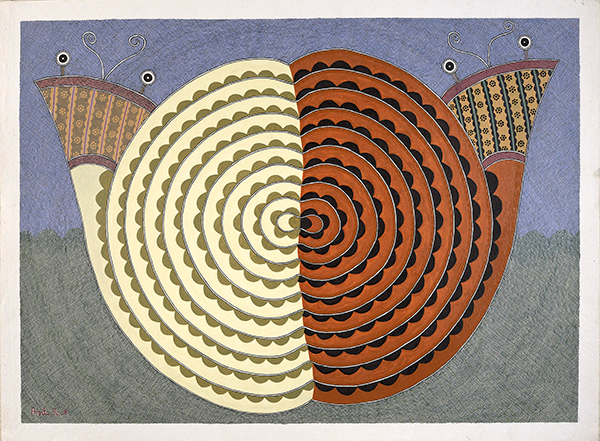
Mithila Painting: The Evolution of an Art Form
EAF, Ethnic Art Foundation Collection of paintings by the Artists of Madhubani, India
Reception: Friday October 12, 5-7pm
Exhibition Dates: Oct 8 to Oct 26, 2012
Pete P. Peters Ellipse Balcony, 3rd Floor, Henry Madden Library
Gallery Hours Monday - Friday 9 to 5pm, Relaxed parking during reception
This exhibition is presented in partnership with the Center for Creativity and the Arts as part of its 2012-2013 theme, Consumption and Sustainability and is Funded by: The Department of Art and Design and ASI, Associated Students, Inc.
Contact: Joan K. Sharma jksharma@csufresno.edu
Mithila painting, as a domestic ritual activity, was unknown to the outside world until the massive Bihar earthquake of 1934. House walls had tumbled down, and the British colonial officer in Madhubani District, William G. Archer, inspecting the damage "discovered" the paintings on the newly exposed interior walls of homes. Archer - later to become the South Asia Curator at London's Victoria and Albert Museum - was stunned by the beauty of the paintings and similarities to the work of modern Western artists like Klee, Miro, and Picasso. During the 1930s he took black and white photos of some of these paintings, the earliest images we have of them.
Mithila had long been famous in India for its rich culture and numerous poets, scholars, and theologians - all men. For women, it has been a deeply conservative society, and until painting on paper began 40+ years ago, most women were confined to their homes and limited to household chores, child rearing, managing family rituals, and ritual wall painting.
In 1977, while conducting research in Madhubani, the beauty of some of the paintings on paper stunned the American anthropologist, Raymond Owens. When Owens returned to the US he showed the paintings to fellow anthropologist, David Szanton, who was equally entranced by them. Then in 1980, with several colleagues they established the Ethnic Arts Foundation (EAF), a non-profit 501(c)3 organization dedicated to sustaining the Mithila painting tradition.
With that in mind, and drawing on a small bequest left by Owens, the EAF established a free Mithila Art Institute (MIA) in Madhubani in 2003 to help develop the next generation of Mithila painters. Given that few young women were learning to paint in the traditional way, from the older women in their families, the hope was that the MAI would encourage the development of a new generation of Mithila painters. Now, nine years later the institute has graduated some 200 students, many having received national and even international recognition.
More broadly, the MAI and EAF are together re-energizing the painting tradition in the surrounding communities through their institutional presence, the students' and graduates' paintings, the painting classes and workshops many graduates now run, and the recognition and income they and others are generating for their work. In the process they are also challenging gender relations and empowering women in this historically conservative patriarchal society.
A woman's painting tradition dating back to at least the 14th century, it is today directly empowering women both through the sale of paintings and more broadly, by providing means to express their increasingly critical views of the world around them.
Artists are being invited to exhibitions across India, and to Europe, the United States, and Japan - no longer as "folk artists," but now as "contemporary artists." Where once their paintings were "anonymous," now they are proudly signed. Along with economic success, opportunities for travel, education, radio, and now television are expanding women's consciousness and engagement with the multiple worlds around them. Gender relations are shifting.
These changes have provoked an argument in Mithila and beyond between cultural conservatives who claim that commercialization and the loss of its ritual functions has debased Mithila painting, versus those who see Mithila Painting as a contemporary art form rooted in the expanding experience, concerns, and freedoms of Mithila's women. Viewers of Mithila Painting: The Evolution of an Art Form are encouraged to form their own judgments.
This exhibition has been organized by the Ethnic Arts Foundation to expand public recognition and appreciation of the painting tradition's beauty, powerful imagery, and capacity to depict classical deities, ancient rituals, and very contemporary national and global issues and events.
Fresno State Students and local community members visited the region and the Mithila Art Institute as part of the 2011 study tour sponsored by the College of Arts and Humanities and the Department of Art and Design and coordinated by Professor Joan K. Sharma.